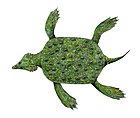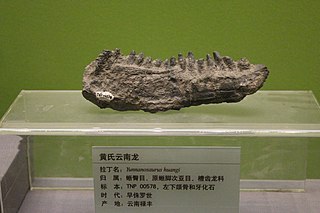
Yunnanosaurus is an extinct genus of sauropodomorph dinosaur that lived approximately 199 to 183 million years ago in what is now the Yunnan Province, in China, for which it was named. Yunnanosaurus was a large sized, moderately-built, ground-dwelling, quadrupedal herbivore, that could also walk bipedally, and ranged in size from 7 meters (23 feet) long and 2 m (6.5 ft) high to 4 m (13 ft) high in the largest species.
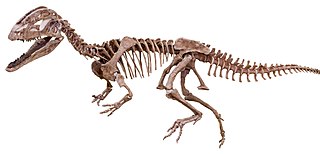
Sinosaurus is an extinct genus of theropod dinosaur which lived during the Early Jurassic Period. It was a bipedal carnivore approximately 5.5 metres (18 ft) in length and 300 kilograms (660 lb) in body mass. Fossils of the animal were found at the Lufeng Formation, in the Yunnan Province of China.
Chinchenia is an extinct genus of a basal pistosauroid known from the Middle Triassic of Guizhou Province, southwestern China. It contains a single species, Chinchenia sungi.
Fenhosuchus is an extinct genus of archosauriform. The holotype, IVPP V 2697, and referred materials have been found in the Hsishihwa locality at Wuhsiang, China, from the Upper Ermaying Formation. The locality dates back to the Anisian stage of the Middle Triassic. The genus was named after the Fen River in Shanxi Province from which specimens were found. It may prove to be a chimera being composed of material from several different animals. Some material were believed to represent a rauisuchid. The calcaneum of Fenhosuchus seems to belong to an erythrosuchid or other basal archosauriform. Much of the material of the tarsal bones seem to be similar to those of the genus Shansisuchus. According to Nesbitt (2009) the assessment of Gower (2000) was correct, the holotype is a mix of Shansisuchus remains and a possible fragment from a paracrocodylomorph or a dinosauriform. Thus, Fenhosuchus cannot be considered a rauisuchian.

Platyognathus is an extinct genus of protosuchian crocodylomorph. Fossils are known from the Early Jurassic Lower Lufeng Formation in Yunnan, China and belong to the type and only species, P. hsui.

Sinosaurosphargis is an extinct genus of basal marine saurosphargid reptile known from the Middle Triassic Guanling Formation of Yunnan and Guizhou Provinces, southwestern China. It contains a single species, Sinosaurosphargis yunguiensis.

Anshunsaurus is a genus of thalattosaurs within the family Askeptosauridae. Fossils have been found from Middle Triassic deposits in Guizhou, China. Three species are known: the type species A. huangguoshuensis, the slightly older species A. wushaensis, and the species A. huangnihensis.
Diandongosaurus is an extinct genus of eosauropterygian known from the lower Middle Triassic of Yunnan Province, southwestern China. It is known from the holotype IVPP V 17761, a complete and articulated skeleton with skull, which was found in the middle Triassic Lagerstätte of the Guanling Formation. It was first named by Qing-Hua Shang, Xiao-Chun Wu, Chun Li in 2011 and the type species is Diandongosaurus acutidentatus. A referred specimen suggests a total body length of 34 cm (13 in).
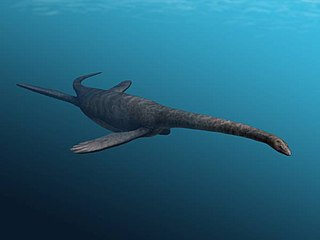
Yunguisaurus is an extinct genus of pistosaur known from the Guizhou Province of China.
Largocephalosaurus is an extinct genus of basal saurosphargid, a marine reptile known from the Middle Triassic Guanling Formation of Yunnan and Guizhou Provinces, southwestern China. It contains a type species, Largocephalosaurus polycarpon, and a second species L. qianensis.

Eumetabolodon is an extinct genus of procolophonine procolophonid parareptile from early and middle Triassic deposits of Nei Mongol, northern China. Two species of Eumetabolodon were named by J. L. Li in 1983 and the type species is Eumetabolodon bathycephalus.
Qianxisaurus is an extinct genus of pachypleurosaur or alternatively a basal eosauropterygian known from the Middle Triassic of Guizhou Province, southwestern China. It contains a single species, Qianxisaurus chajiangensis.
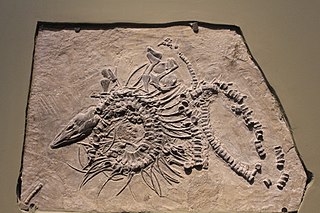
Xinpusaurus is an extinct genus of thalattosaur from the Late Triassic of Guanling in Guizhou, China. Several species have been named since 2000: the type species X. suni along with the species X. bamaolinensis and X. kohi. A 2013 study proposed that all three species are synonymous with each other, in which case X. suni would be the only valid species, although a 2014 study argued that X. kohi was also valid. A fourth species, X. xingyiensis, was described in 2016.
Xinminosaurus is an extinct genus of cymbospondylid ichthyosaur known from the Middle Triassic of Guizhou Province, China.
Kwangsisaurus is an extinct genus of a basal pistosauroid known from the Early or Middle Triassic of Guangxi, southern China. It contains a single species, Kwangsisaurus orientalis.

Saurosphargidae is an extinct family of marine reptiles known from the Early Triassic and early Middle Triassic of Europe and China.
Saurosphargis is an extinct genus of a basal marine reptile, saurosphargid, known from the Middle Triassic of southwestern Poland and eastern Netherlands. It contains a single species, Saurosphargis volzi.
Panzhousaurus is an extinct genus of pachypleurosaur from the Middle Triassic of China. The type species is P. rotundirostris. The preserved portion of the holotype measures 36 cm (14 in) long, and its total body length may have been less than 50 cm (20 in).

Luopingosaurus is an extinct genus of pachypleurosaurid sauropterygian from the Middle Triassic Guanling Formation of Yunnan Province, China. The genus contains a single species, L. imparilis, known from a well-preserved, nearly complete skeleton.
Gracilicollum is an extinct genus of likely tanystropheid archosauromorph from the Middle Triassic (Anisian) Guanling Formation of China. The genus contains a single species, G. latens, known from a skull and partial neck.









